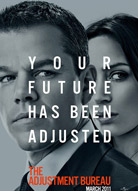 ...almost never saw, or is it? Paolo here again. I'd normally be the first person to watch a movie that features attractive men wearing fedoras and Emily Blunt doing contemporary dance, but fate had other plans. But between The Adjustment Bureau's theatrical release and now, it was a movie that had a minor 'bucket list effect' on me.
...almost never saw, or is it? Paolo here again. I'd normally be the first person to watch a movie that features attractive men wearing fedoras and Emily Blunt doing contemporary dance, but fate had other plans. But between The Adjustment Bureau's theatrical release and now, it was a movie that had a minor 'bucket list effect' on me.
In one of its DVD extras 'Leaping through New York,' writer/director George Nolfi praises the city as an all around "magical place". But the film's visual version of New York is underwhelming and dour, since we mostly see colours like blue and grey and it seemingly takes place in perpetual dawn or autumn. That's how I felt the first time, although repeated viewings made me appreciate how the sunlight would hit on the upper half of the city's Metropolis-like art deco skyscrapers.
New York, as this film depicts is, makes its citizens feel anomic. We get this feeling specifically through the way the titular adjusters are depicted within the shots, as when four mid-level adjusters look out from a rooftop to countless windows in front of them. That image is essentially repeated when two adjusters Harry (Anthony Mackie) and Richardson (John Slattery) look out a window inside the bureau. A high angle long shot of the bureau's library before we see Harry thinking about one of his cases, David (Matt Damon) offers a similar feeling. The city is an overwhelmingly large frame for an internal and masculine struggle, as Harry becomes wary of how his job affects others. But maybe the film dwarfs the adjusters to highlight a part of their function, to have the least ripple effects, as invisible, microscopic, unnoticed.
David and his star crossed lover Elise (Blunt) are also lonely people without family... but they dominate the shots they're in, in a way the adjusters don't, adding warmth to these characters so that they don't feel so isolated. When Elise finds herself at the foot the Statue of Liberty, we see her anguished expression before we see the monument behind her. They feel small compared to the city only when they run to the top of the bureau and understand the large forces that they are fighting to be together.
The film doesn't always fully convince with its premise, like the adjusters being narrative devices, Thompson (Terence Stamp) pontificating about world history or the significant powers within the adjusters' hats. And is it bad if I say that this movie doesn't have the same visual cues as sci-fi films and thus my disbelief had to be beaten into me? However, the most crucial thing it successfully sells is Blunt and Damon's chemistry which, in a romance, is all we really need. Eye Weekly's Jason Anderson even compared their screen connection to Bogie and Bacall, and that's a thought to consider. Blunt gets the better lines, hitting the right note of Elise's flirtatious spin on her slight anger, but both actors embody the film's real premise of human constancy stronger than time and a big city.
Special features include deleted scenes, making-of doc, featurettes about Blunt and Damon's chemistry and on Blunt's dance training, Nolfi's commentary, DVS and English, French and Spanish audio and subtitles.
Also newish on DVD is another dance movie, Mao's Last Dancer, a crowd pleaser two years ago at TIFF because it's about some impoverished man's triumph and the cutthroat volatility of the ballet industry. But for me this movie exists so I can geek out on 80's fashion as well as performances of "Swan Lake," "The Rite of Spring" and the avuncular Bruce Greenwood teaching supposedly emotionally detached Chinese ballet dancers some Gershwin. Extras include French audio.

[ETA and sorry: Also newish on DVD is another sci-fi lurve story Source Code, which has unavoidable CGI but also has a more lively and diverse colour palette and lighting although both aspects can look conventional at times. The camera still does good work in capturing Jake Gyllenhaal's expressive face. Special making-of features include the cast being very honest, funny and insightful about breathing life into the film's concept, as well as seven minutes of mind-numbing science.]
